Digital Mapping of Habitat for Plant Communities Based on Soil Functions: A Case Study in the Virgin Forest-Steppe of Russia
Abstract
:1. Introduction
2. Materials and Methods
3. Results
3.1. Soils of the Study Site and the Factors Controlling Soil Properties Variety
3.2. Vegetation Cover of Key Area and Relation of Vegetation Characteristics with Soil Moisture
3.3. Prediction and Verification of Habitat for Plants Soil Map Based on Soil Function
4. Discussion
5. Conclusions
- Soil moisture is the leading factor that determines the soil habitat for natural plant communities’ conditions variety in the virgin forest-steppe at a local level;
- There are two stable soil habitats for natural plant communities types: mesophytic communities on the phaeozems (with additional runoff more than 80 mm) and xerophytic communities on chernozems (additional runoff less than 55 mm).
- Map of habitat for plant communities in relationships with soil function allows us to predict the species composition, its distribution and abundance, the ecological and coenotic structure of steppe meadows and plant communities’ ecological specificity in relation to their requirements for soil moisture conditions.
Supplementary Materials
Author Contributions
Funding
Acknowledgments
Conflicts of Interest
References
- Bouma, J. Soil science contributions towards Sustainable Development Goals and their implementation: Linking soil functions with ecosystem services. J. Plant Nutr. Soil Sci. 2014. [Google Scholar] [CrossRef]
- Greiner, L.; Keller, A.; Grêt-Regamey, A.; Papritz, A. Soil function assessment: Review of methods for quantifying the contributions of soils to ecosystem services. Land Use Policy 2017. [Google Scholar] [CrossRef]
- McBratney, A.; Field, D. Securing our soil. Soil Sci. Plant Nutr. 2015, 61, 587–591. [Google Scholar] [CrossRef] [Green Version]
- Calzolari, C.; Ungaro, F.; Filippi, N.; Guermandi, M.; Malucelli, F.; Marchi, N.; Tarocco, P. A methodological framework to assess the multiple contributions of soils to ecosystem services delivery at regional scale. Geoderma 2016. [Google Scholar] [CrossRef]
- Jiang, J.; Wang, Y.; Yu, M.; Li, K.; Shao, Y.; Yan, J. Science of the Total Environment Responses of soil buffering capacity to acid treatment in three typical subtropical forests. Sci. Total Environ. 2016, 563–564, 1068–1077. [Google Scholar] [CrossRef] [PubMed]
- Li, S.X.; Wang, Z.H.; Miao, Y.F.; Li, S.Q. Soil Organic Nitrogen and Its Contribution to Crop Production. J. Integr. Agric. 2014, 13, 2061–2080. [Google Scholar] [CrossRef]
- Wang, Y.; Zhao, X.; Guo, Z.; Jia, Z.; Wang, S.; Ding, K. Soil & Tillage Research Response of soil microbes to a reduction in phosphorus fertilizer in rice—Wheat rotation paddy soils with varying soil P levels. Soil Tillage Res. 2018, 181, 127–135. [Google Scholar] [CrossRef]
- Lehmann, A.; Stahr, K. The potential of soil functions and planner-oriented soil evaluation to achieve sustainable land use. J. Soils Sediments 2010, 10, 1092. [Google Scholar] [CrossRef]
- Rabot, E.; Wiesmeier, M.; Schlüter, S.; Vogel, H.J. Soil structure as an indicator of soil functions: A review. Geoderma 2018. [Google Scholar] [CrossRef]
- Bashir, H.; Ahmad, S.S. Ordination classification of relationship of vegetation and soil’s edaphic factors along the roadsides of Wahcantt, Pakistan. J. King Saud Univ. Sci. 2018. [Google Scholar] [CrossRef]
- Liu, S.; Hou, X.; Yang, M.; Cheng, F.; Coxixo, A.; Wu, X. Factors driving the relationships between vegetation and soil properties in the Yellow River Delta, China. Catena 2018, 165, 279–285. [Google Scholar] [CrossRef]
- Faucon, M.; Houben, D.; Lambers, H. Plant Functional Traits: Soil and Ecosystem Services. Trends Plant Sci. 2017, 22, 385–394. [Google Scholar] [CrossRef] [PubMed]
- Drobnik, T.; Greiner, L.; Keller, A.; Grêt-Regamey, A. Soil quality indicators—From soil functions to ecosystem services. Ecol. Indic. 2018. [Google Scholar] [CrossRef]
- Haslmayr, H.P.; Geitner, C.; Sutor, G.; Knoll, A.; Baumgarten, A. Soil function evaluation in Austria—Development, concepts and examples. Geoderma 2016. [Google Scholar] [CrossRef]
- Clapperton, M.J.; Chan, K.Y.; Larney, F.J. Managing the Soil Habitat for Enhanced Biological Fertility. In Soil Biological Fertility; Abbott, L.K., Murphy, D.V., Eds.; Springer: Dordrecht, The Netherlands, 2007. [Google Scholar]
- Koptsik, S.V.; Koptsik, G.N.; Livantsova, S.Y.; Berezina, N.A.; Vakhrameeva, M.G. Analysis of the Relationship between Soil and Vegetation in Forest Biogeocenoses by the Principal Component Method. Russ. J. Ecol. 2003, 34, 37–45. [Google Scholar] [CrossRef]
- Cachovanová, L.; Hájek, M.; Fajmonová, Z.; Marrs, R. Species Richness, Community Specialization and Soil-Vegetation Relationships of Managed Grasslands in a Geologically Heterogeneous Landscape. Folia Geobot. 2012, 47, 349–371. [Google Scholar] [CrossRef]
- Dufrene, M.; Legendre, P. Species assemblages and indicator species: The need for a flexible asymmetrical approach. Ecol. Monogr. 1997, 67, 345–366. [Google Scholar] [CrossRef]
- Eremenko, E.A.; Panin, A.V. Lozhbinnyj Mezorel’ef Vostochno-Evropejskoj Ravniny; MIROS: Moscow, Russia, 2010. (In Russian)
- Landolt, E. Ökologische Zeigerwerts zur Sweizer Flora; Veröffentlichungen des Geobotanischen Institutes der Eidg. Tech. Hochschule: Zurich, Switzerland, 1977; pp. 1–208. [Google Scholar]
- Ehrmann, J.; Ritz, K. Plant:soil interactions in temperate multi-cropping production systems. Plant Soil 2013, 376. [Google Scholar] [CrossRef]
- Montanarella, L.; Badraoui, M.; Chude, V.; Costa, I.D.; Mamo, T.; Yemefack, M.; Aulang, M.; Yagi, K.; Hong, S.Y.; Vijarnsorn, P.; et al. Status of the World’s Soil Resources (SWIR)—Main Report; FAO: Room, Italy, 2015. [Google Scholar]
- Fishman, M.I. Chernozemnye kompleksy i ih svyaz’ s rel’efom na Srednerusskoj vozvyshennosti. Pochvovedenie 1977, 5, 17–29. (In Russian) [Google Scholar]
- Neteler, M.; Bowman, M.H.; Landa, M.; Metz, M. GRASS GIS: A multi-purpose open source GIS. Environ. Model. Softw. 2012, 3, 124–130. [Google Scholar] [CrossRef]
- Oliver, M.A.; Webster, R. Basic Steps in Geostatistics: The Variogram and Kriging; Springer: Berlin, Germany. [CrossRef]
- Velichko, A.A.; Morozova, T.D.; Nechaev, V.P.; Porozhnjakova, O.M. Paleokriogenez, Pochvennyj Pokrov i Zemledelie; Nauka: Moscow, Russia, 1996. (In Russian) [Google Scholar]
- Agrofizicheskaya Harakteristika Pochv-stepnoj i Suhostepnoj Zon Evropejskoj Chasti; SSSR: Moscow, Russia, 1977. (In Russian)
- Šustić, D.; Tadić, Z.; Tadić, L.; Kržak, T. Hydrologic and hydraulic analysis of less studied watershed. Energy 2008, 1, 1–10. [Google Scholar]
- Koco, Š. Simulation of gully erosion using the SIMWE model and GIS. Landf. Anal. 2011, 17, 81–86. [Google Scholar]
- IUSS Working Group WRB. World Reference Base for Soil Resources 2014, Update 2015 International Soil Classification System for Naming Soils and Creating Legends for Soil Maps; World Soil Resources Report No. 106; FAO: Rome, Italy, 2015. [Google Scholar]
- Arinushkina, E.V. Guide on Soils Chemical Analysis; Moscow State University: Moscow, Russia, 1970; p. 488. (In Russian) [Google Scholar]
- Onipchenko, V.G.; Semenova, G.V. Comparative analysis of the floristic richness of alpine communities in the Caucasus and the Central Alps. J. Veg. Sci. 1995, 6. [Google Scholar] [CrossRef]
- Hopkins, B. The species-area relations of plant communities. J. Ecol. 1955, 43, 409–426. [Google Scholar] [CrossRef]
- Conrad, O.; Bechtel, B.; Bock, M.; Dietrich, H.; Fischer, E.; Gerlitz, L.; Wehberg, J.; Wichmann, V.; Böhner, J. System for Automated Geoscientific Analyses (SAGA) v. 2.1.4. Geosci. Model Dev. 2015, 8. [Google Scholar] [CrossRef]
- Bell, J.C.; Cunningham, R.L.; Havens, M.W. Soil Drainage Class Probability Mapping Using a Soil-Landscape Model. Soil Sci. Soc. Am. 1994, 58. [Google Scholar] [CrossRef]
- Webster, R.; Burrough, P.A. Multiple discriminant analysis in soil survey. Eur. J. Soil Sci. 1974, 25, 120–134. [Google Scholar] [CrossRef]
- Moser, B.; Büntgen, U.; Molinier, V.; Peter, M.; Sproll, L.; Stobbe, U.; Tegel, W.; Egli, S. Ecological indicators of Tuber aestivum habitats in temperate European beech forests. Fungal Ecol. 2017, 29, 59–66. [Google Scholar] [CrossRef]
- Odland, A. Interpretation of altitudinal gradient in South central Norway based on vascular plants as environmental indicators. J. Ecol. Indic. 2009, 9, 409–421. [Google Scholar] [CrossRef]
- Smirnov, V.E.; Khanina, L.G.; Bobrovsky, M.V. Validation of the Ecological-Coenotical groups of vascular plant species for European Russian forests on the basis of ecological indicator values, vegetation releves and statistical analysis. Bull. Mosk. Obs. Ispit. Prir. 2006, 111, 36–47. (In Russian) [Google Scholar]
- Clarke, K.R. Non-parametric multivariate analyses of changes in community structure. Aust. J. Ecol. 1993, 18, 117–143. [Google Scholar] [CrossRef]
- Hammer, Ø.; Harper, D.A.T.; Ryan, P.D. PAST: Paleontological Statistics Software Package for Education and Data Analysis. Palaeontol. Electron. 2001, 4, 1–9. [Google Scholar]
- Sanderman, J. Can management induced changes in the carbonate system drive soil carbon sequestration? A review with particular focus on Australia. Agric. Ecosyst. Environ. 2012, 155, 70–77. [Google Scholar] [CrossRef]
- Vereecken, H.A.; Schnepf, J.W.; Hopmans, M.; Javaux, D.; Or, T.; Roose, J.; Vanderborght, M.H.; Young, W.; Amelung, M.; Aitkenhead, S.D.; et al. Modeling Soil Processes: Review, Key Challenges, and New Perspectives. Vadose Zone J. 2016, 15, 1–57. [Google Scholar] [CrossRef]
- Korolyuk, A.Y. Ecological preferences of plants on the south of Siberia. Bot. Issled. Sib. Kazakhstana 2006, 12, 3–38. (In Russian) [Google Scholar]
- Kervroëdan, L.; Armand, R.; Saunier, M.; Ouvry, J.; Faucon, M. Plant functional trait e ff ects on runo ff to design herbaceous hedges for soil erosion control. Ecol. Eng. 2018, 118, 143–151. [Google Scholar] [CrossRef]
- Berendse, F.; van Ruijven, J.; Jongejans, E.; Keesstra, S. Loss of plant species diversity reduces soil erosion resistance. Ecosystems 2015, 18, 881–888. [Google Scholar] [CrossRef]
- Lambrechts, T.; François, S.; Lutts, S.; Muñoz-Carpena, R.; Bielders, C.L. Impact of plant growth and morphology and of sediment concentration on sediment retention efficiency of vegetative filter strips: Flume experiments and VFSMOD mod. J. Hydrol. 2014, 511, 800–810. [Google Scholar] [CrossRef]
- Gyssels, G.; Poesen, J.; Bochet, E.; Li, Y. Impact of plant roots on the resistance of soils to erosion by water: A review. Prog. Phys. Geogr. 2005, 29, 189–217. [Google Scholar] [CrossRef]
- Adhikari, K.; Hartemink, A.E. Linking soils to ecosystem services—A global review. Geoderma 2016, 262, 101–111. [Google Scholar] [CrossRef]
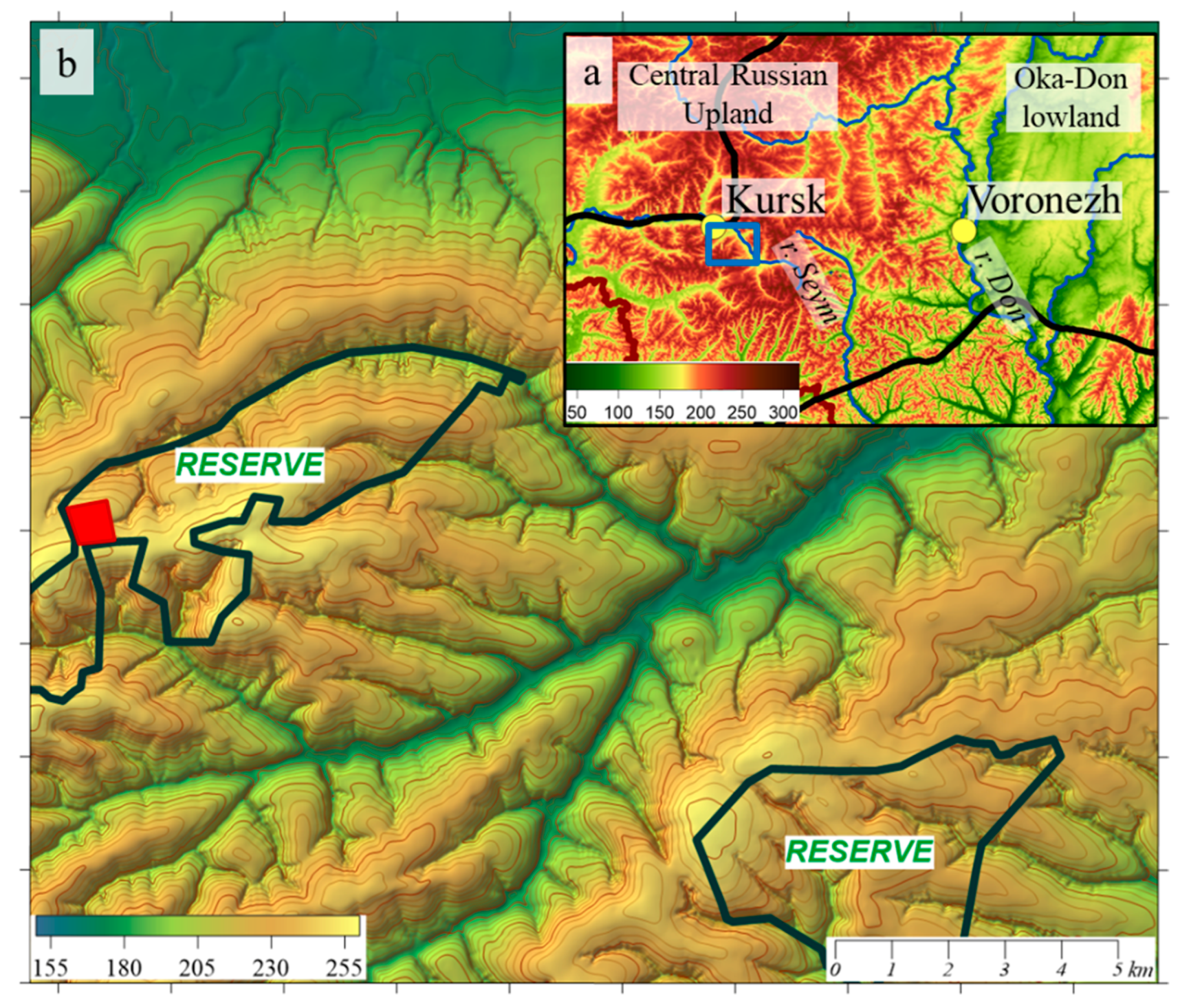
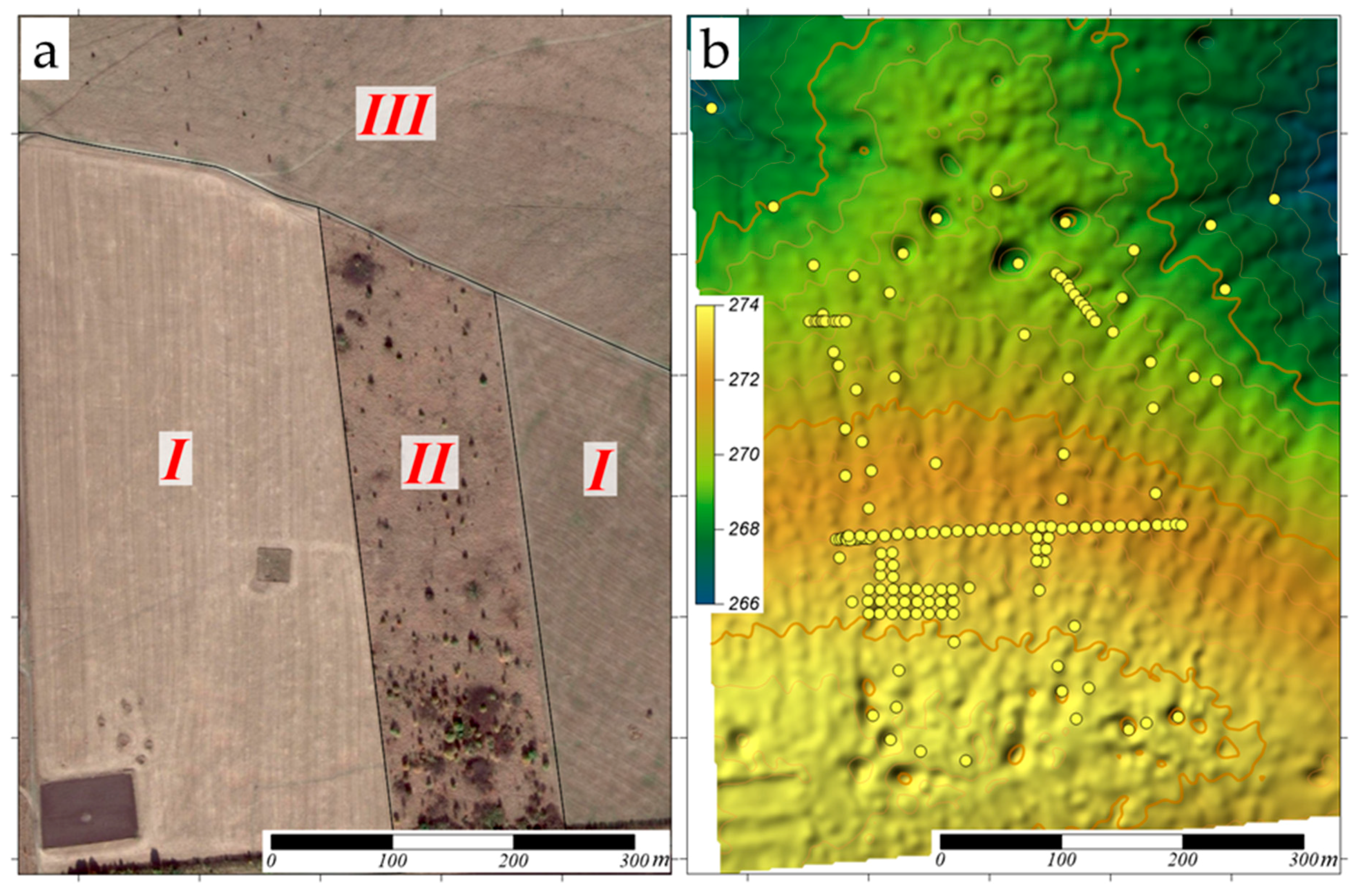
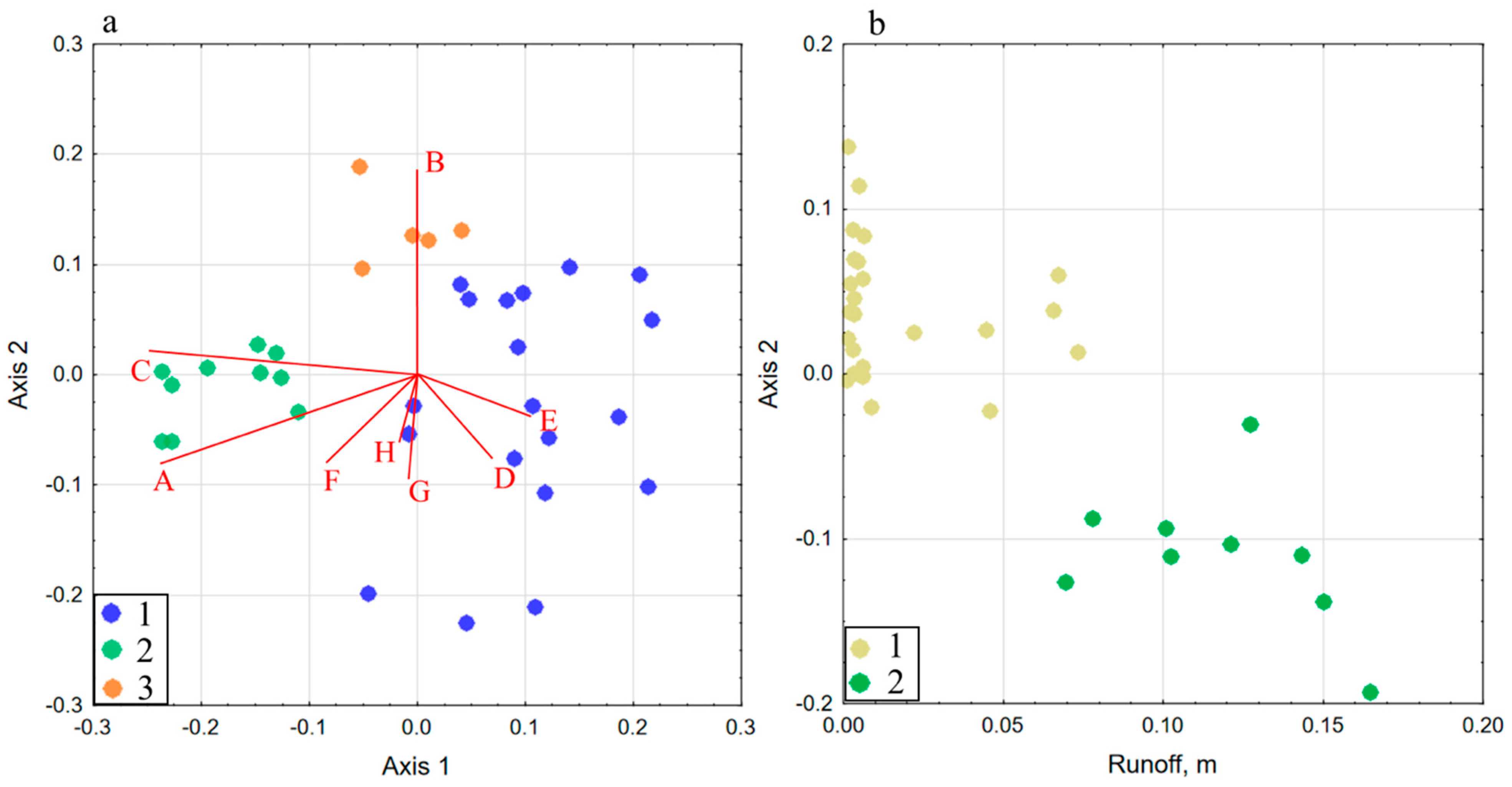
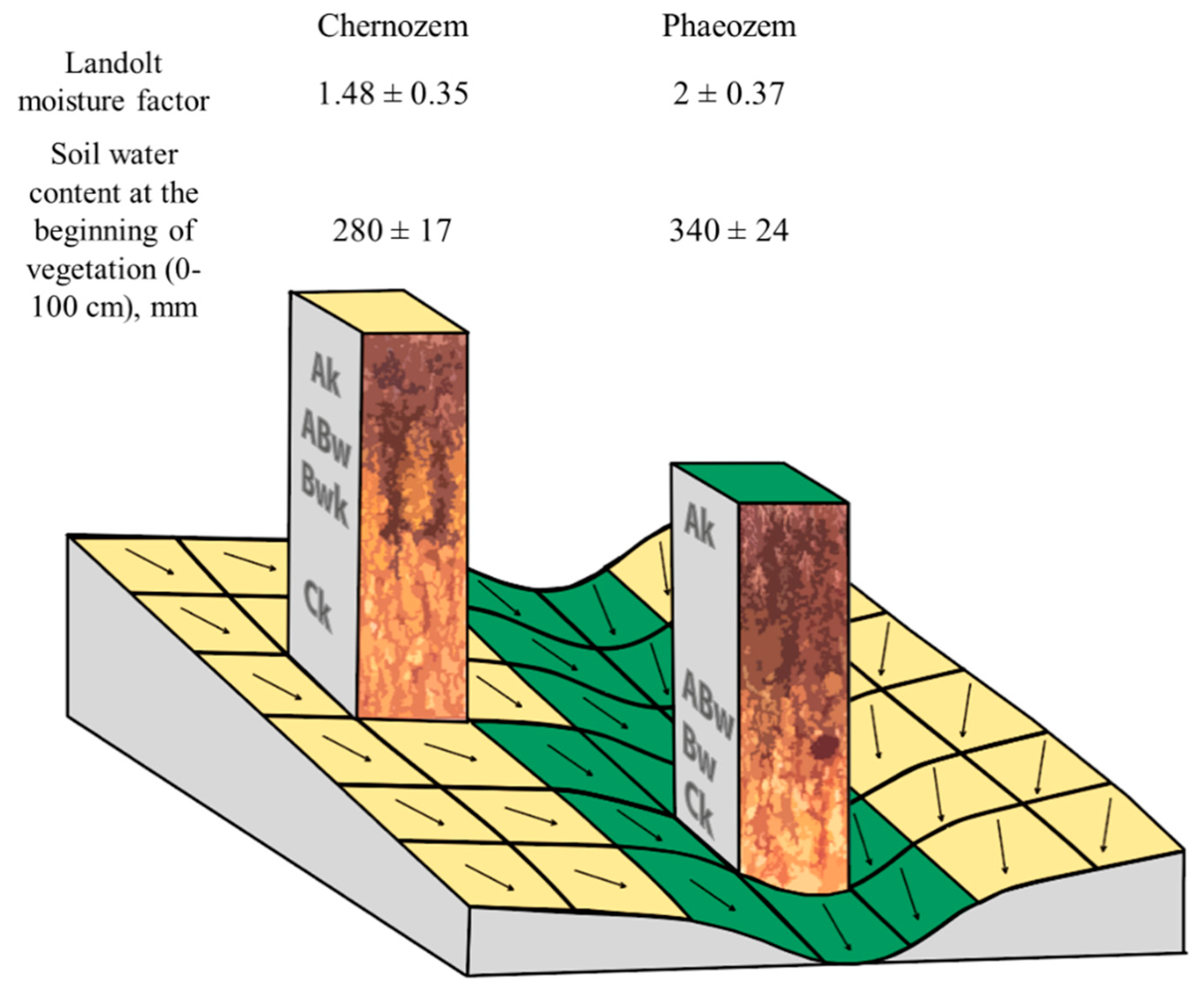
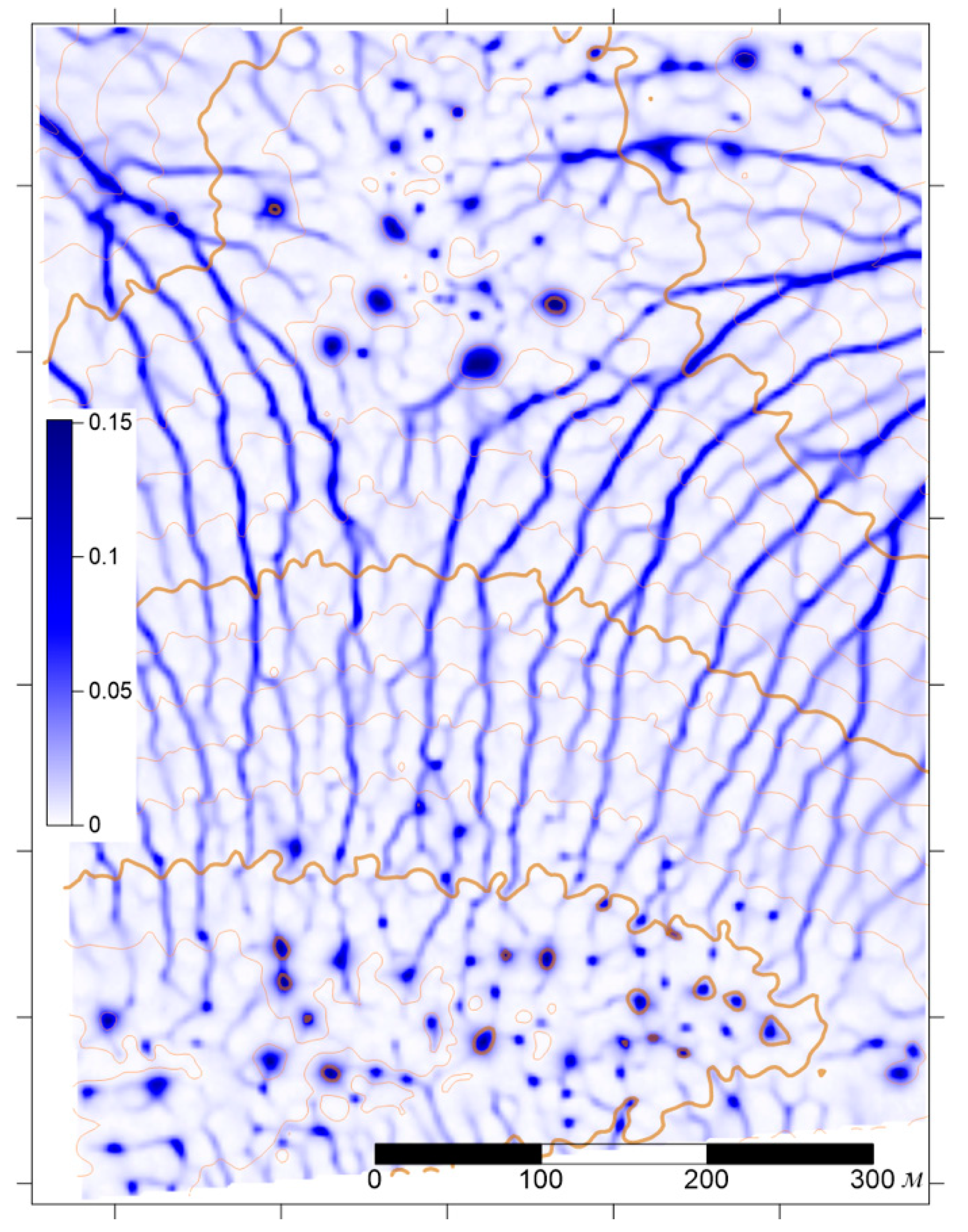
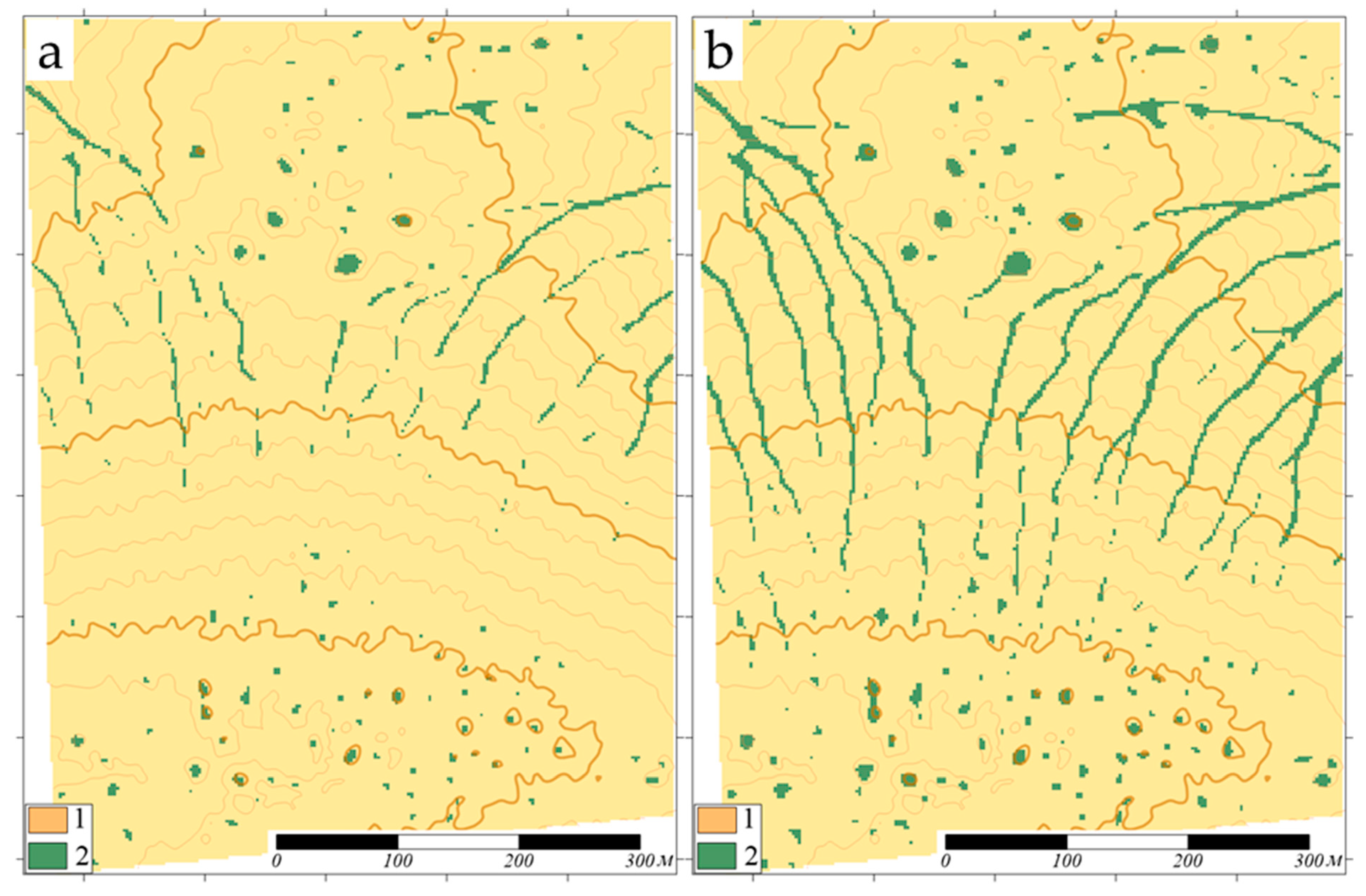
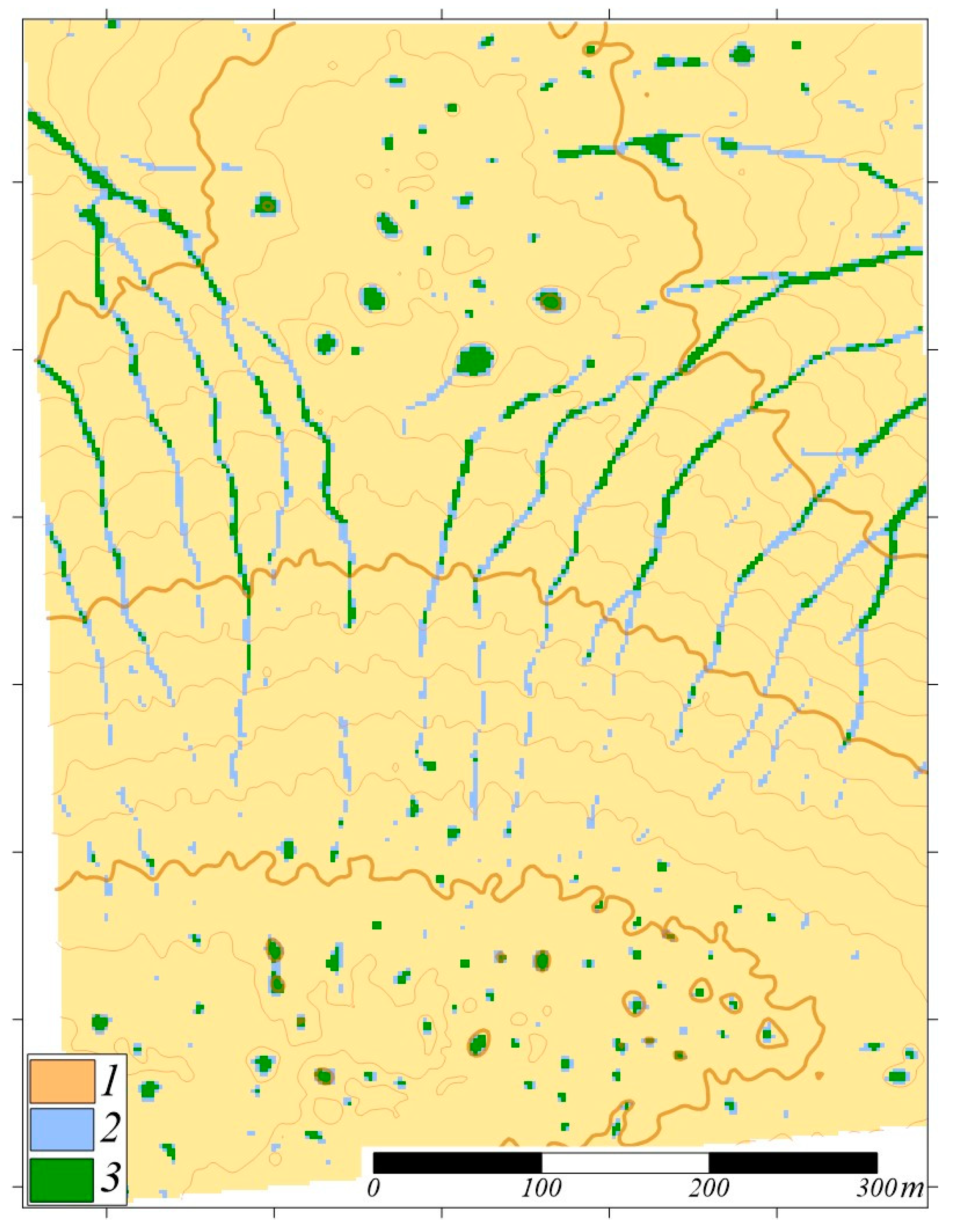
| Life Forms | Soil Reference Groups | |
|---|---|---|
| Chernozem | Phaeozem | |
| Sod perennial species | 7 | 7 |
| Short rhizomatous perennial species | 23 | 20 |
| Long rhizomatous perennial species | 19 | 23 |
| Stoloniferous perennial species | 26 | 29 |
| Bulbous species | 1 | 1 |
| Annual species | 5 | 6 |
| Shrub and semi-shrub species | 2 | 2 |
| Summ | 83 | 88 |
| Soil Reference Groups | |||
|---|---|---|---|
| Vegetation types | chernozems | phaeozems | |
| Xero-mesophytes | 1(33) | 0 | |
| Mesophytes | 2(1.5) | 3(1) | |
© 2019 by the authors. Licensee MDPI, Basel, Switzerland. This article is an open access article distributed under the terms and conditions of the Creative Commons Attribution (CC BY) license (http://creativecommons.org/licenses/by/4.0/).
Share and Cite
Lozbenev, N.; Smirnova, M.; Bocharnikov, M.; Kozlov, D. Digital Mapping of Habitat for Plant Communities Based on Soil Functions: A Case Study in the Virgin Forest-Steppe of Russia. Soil Syst. 2019, 3, 19. https://doi.org/10.3390/soilsystems3010019
Lozbenev N, Smirnova M, Bocharnikov M, Kozlov D. Digital Mapping of Habitat for Plant Communities Based on Soil Functions: A Case Study in the Virgin Forest-Steppe of Russia. Soil Systems. 2019; 3(1):19. https://doi.org/10.3390/soilsystems3010019
Chicago/Turabian StyleLozbenev, Nikolai, Maria Smirnova, Maxim Bocharnikov, and Daniil Kozlov. 2019. "Digital Mapping of Habitat for Plant Communities Based on Soil Functions: A Case Study in the Virgin Forest-Steppe of Russia" Soil Systems 3, no. 1: 19. https://doi.org/10.3390/soilsystems3010019
APA StyleLozbenev, N., Smirnova, M., Bocharnikov, M., & Kozlov, D. (2019). Digital Mapping of Habitat for Plant Communities Based on Soil Functions: A Case Study in the Virgin Forest-Steppe of Russia. Soil Systems, 3(1), 19. https://doi.org/10.3390/soilsystems3010019





